
The Yarf! reviews by Fred Patten
Note: This is a fraction of the entire listing. If you’re on broadband, you might want to try the high speed version instead.

The Yarf! reviews by Fred Patten
Note: This is a fraction of the entire listing. If you’re on broadband, you might want to try the high speed version instead.
Welcome to the “Patten’s reviews” wing of the Anthro Library! Since this is a collection of columns from a dormant (if not dead) furzine called YARF!, a word of explanation might be helpful: In its day, YARF! (aka ‘The Journal of Applied Anthropomorphics’) was perhaps the best-known—and best in quality—of furry zines. Started in 1990 by Jeff Ferris, YARF!’s roster of contributors reads like a Who’s Who of furdom in the last decade of the 20th Century. In any issue, the zine’s readers could expect to enjoy work by the likes of Monika Livingstone, Watts Martin, Ken Pick, and Terrie Smith; furry comic strips such as Mark Stanley’s Freefall… and Fred Patten’s reviews of furry books and comics.
Unfortunately, YARF! has been thoroughly inactive since its 69th issue, which was released in September 2003. We can’t say whether YARF! will ever rise again… but at least we can prevent its reviews from falling into disremembered oblivion. And so, with the active cooperation of Mr. Patten, Anthro is proud to present Mr. Patten’s review columns—including the final one, which would have appeared in the never-printed YARF! #70.
Full disclosure: For each reviewed item, we’ve provided links you can use to check which of four different online booksellers—Amazon.com
, Barnes & Noble
, Alibris
, and Powell’s Bookstore—now has it in stock. Presuming the item in question is available, if you buy it Anthro gets a small percentage of the price.
 #45 / Nov 1996 |
||||
|
|
|
|||
|
|
|
|||
|
|
|
|||
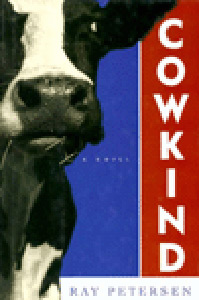 |
||
| Title: | Cowkind | |
| Author: | Ray Petersen | |
| Publisher: |
A Wyatt Book for St. Martin’s Press (New York City, NY), Jun 1996 |
|
| ISBN: | 0-312-14302-8 | |
|
viii + 195 pages, $21.95 |
||
| Availability: | Am |
|
Cows are an unusual cast for serious fiction. But Cowkind is an unusual novel. Its topic is Rural America in a time of transition, at the end of the 1960s; from the viewpoints of both the farmers and the livestock.
Cowkind is told in twelve chapters, each focusing upon a different character living at Bob Scott’s dairy farm in upstate New York. The first seven chapters relate the viewpoints of five of Farmer Bob’s milk cows and their calves; White John, the farm’s stud bull; and King, the farm’s border collie. The remaining five chapters switch the focus to the humans; Farmer Bob, his wife, son, & daughter, with a final shift back to the cows in the next-to-last chapter.
Petersen develops the overall scene slowly in a convoluted, jigsaw manner. The novel not only moves from character to character, but it jumps around in time, from the present (1971) back to 1968, and slowly working forward to 1971 again; with flashbacks within each chapter to still earlier events.
The daily farm routine is all that the characters have known, from ‘time immemorial’. Farmer Bob inherited the farm from his father, and he expects to leave it to his teenaged son, Gerry. The pattern of life to Bob is growing up on the farm as a boy, undergoing a Rite of Manhood by fighting for America as a teen (his father in World War I; himself in World War II), then returning to the farm to work it until old age and death. The dairy herd have their similar life, the Order; the same from day to day, comfortably familiar.
The opening establishes that the characters are nervous and uneasy, without knowing why. Changes are coming that bewilder them. The cows are distraught that Bob and Gerry and their part-time helper, Bob’s brother Merle, have replaced traditional hand-milking with milking machines. Bossy, Daisy, and the others do not understand why the human men who used to give them such personal, caring attention have abandoned them to be hooked up to cold machines. Pet has heard the men saying something about the milk going into ‘tanks’, and they have also overheard ‘tanks’ talked about on the farm TV’s newscasts about the Vietnam war, so the cattle wonder whether they have somehow become involved in this war to which Gerry is so opposed.
Bob himself is no more comfortable with the changing world. He only realizes that his farm is losing money, that it is becoming increasingly old-fashioned, and that to stay out of bankruptcy he must invest in lots of modern technology that he does not really trust. He also does not know how the government can take away part of his farm for things like power-line right-of-ways. He reacts by concentrating on the one thing that he feels he can understand and control: his family. He was just as traditional about how the house should be run. Men worked outside and women worked inside, except when the men needed help. Inside, men were waited on, served their three square meals—breakfast, dinner, and supper. (pg. 5) But this Biblically patriarchial way of life is as old-fashioned as his farming methods.
To anthropomorphic fans, the best part of Cowkind will be the first 2/3 of the novel. It starts by establishing the male and female cattle as individuals, with distinct personalities and their own small society. This Order, and the cows’ religion, the Gathering, are gradually revealed as the cows discuss the changes that are taking place, and what they will mean to them. These changes are first glimpsed in a distorted manner from the cows’ viewpoints. (Petersen shows a thorough knowledge of farm routine and the actual sociology of dairy cattle.) The reader will later translate them into human terms and realize what is really happening. There are also parallels between the tensions and problems introduced with the cattle, and what is later seen happening within Farmer Bob’s family.
It is technically unfortunate from our standpoint that the cows’ society gradually fades into the background as the story increasingly focuses upon the Scotts and their problems. But Petersen is a good enough writer that the reader will remain engrossed until the end. This is good, because there is an anthropomorphic surprise in the last chapter. The social situation among the cows, and between King and his relationship with the neighboring farm’s dog, Scout, make Cowkind worth reading even if they do not fill the book. Most intriguing is Aretha, the mystical cow, a Cassandra whose nightmarish visions of where the trends in modern farming are leading are mocked by her stablemates:
Aretha was lost in a vision of the future, delirious. She saw calves stillborn, aborted spontaneously, born as monsters with two heads, no legs, calves destroyed by the ruin of the air and the land. She saw all the elders slaughtered, no cows allowed to grow old, none ever let outside to graze or to feel sunshine, cows alive only to give milk or their flesh for humans to eat. Each vision was more frightening than the previous one. Supercows—the product of chemicals and growth hormones, until humans were afraid of milk, cheese, and butter from real cows. Then vats of bacteria digesting grain and grass, oozing out milk that had never touched a cow’s stomach. Finally extinction, humans completely cut off from the rest of creation, and doing their best to accelerate the process. (pg. 147)
| The Animorphs series, by K. A. Applegate | ||||
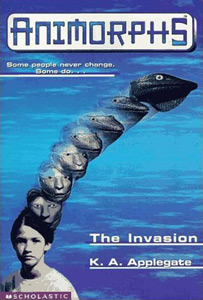 |
||||
| Title: | Animorphs: The Invasion | |||
| Publisher: | Scholastic Inc./Apple Paperback (New York, NY), Jun 1996 | |||
| ISBN: | 0-590-62977-8 | |||
| 184 pages, $3.99 | ||||
| Availability: | Am |
|||
|
|
||||
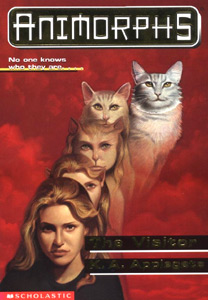 |
||||
|
|
||||
| Title: | Animorphs: The Visitor | |||
| Publisher: | Scholastic Inc./Apple Paperback (New York, NY), Jun 1996 | |||
| ISBN: | 0-590-62978-6 | |||
| 175 pages, $3.99 | ||||
| Availability: | Am |
|||
|
|
||||
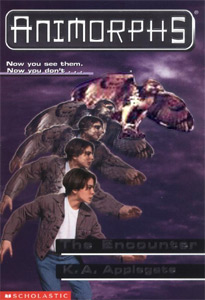 |
||||
|
|
||||
| Title: | Animorphs: The Encounter | |||
| Publisher: | Scholastic Inc./Apple Paperback (New York, NY), Aug 1996 | |||
| ISBN: | 0-590-62979-4 | |||
|
154 pages [pgs. 155-157 are adv’ts], $3.99 |
||||
| Availability: | Am |
|||
|
|
||||
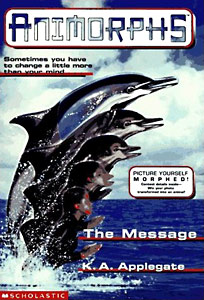 |
||||
|
|
||||
| Title: | Animorphs: The Message | |||
| Publisher: | Scholastic Inc./Apple Paperback (New York, NY), Oct 1996 | |||
| ISBN: | 0-590-62980-8 | |||
| 151 pages, $3.99 | ||||
| Availability: | Am |
|||
|
|
||||
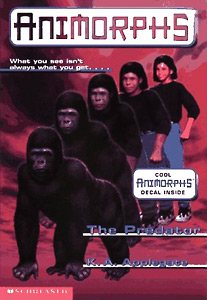 |
||||
|
|
||||
| Title: | Animorphs: The Predator | |||
| Publisher: | Scholastic Inc./Apple Paperback (New York, NY), Dec 1996 | |||
| ISBN: | 0-590-62981-6 | |||
|
152 pages, $3.99 |
||||
| Availability: | Am |
|||
This Young Adult series is a new entry in the juvenile/adolescent horror series-paperback market. Instead of featuring independent weird fantasies like R. L. Stine’s Goosebumps best-sellers, it is a super-hero continuing serial which should be read in order for best effect. Each novel presents a complete adventure, but while the first three stand on their own nicely, there is enough backstory by the fourth to make it inadvisable to start reading that far into the series.
A good ‘high concept’ summary of Animorphs would be, “Marvel Comics’ Power Pack juvenile super-heroes tumble into Robert Heinlein’s Puppet Masters world”. Jake, Rachel, Tobias, Marco, and Cassie are five junior-high-school good buddies (a P.C. gender/ethnic mix), returning to their homes from hanging out at the mall one evening. They are cutting across an abandoned construction project when a battle-battered flying saucer crash-lands almost on top of them. Its vaguely deer-centauroid pilot, a mortally wounded heroic Andalite, reveals that his planet is fighting the evil Yeerks who are trying to conquer the galaxy. The Yeerks—…a gray-green, slimy thing like a snail without its shell, only bigger, the size of a rat, maybe.. (The Invasion, pg. 17)—have recently discovered Earth. They are establishing their beachhead in the kids’ home town, by crawling into people’s ears and taking over their bodies. The city government, the police force, their teachers, anybody could be a Yeerk puppet by now. The dying Andalite prince has sent a galactic radio message to his distant planet to come to Earth’s aid, but Earth may be totally enslaved before their armada can get here. Only the five teens can save Earth, by delaying the spread of the Yeerks until the Andalites arrive!
The Andalite’s last act is to give the buddies his species’ super-scientific power to morph into any kind of animal. As dogs or cats, they can spy unnoticed and discover which of their neighbors are now Yeerk thralls. As birds, they can observe from great heights. They can sneak into Yeerk control centers as mice, then turn into elephants and trample irreplaceable equipment. And so forth.
The writing generates a reasonable degree of suspense, if you don’t mind the super-hero/horror-movie level of science or logic. (The Yeerks’ takeover method postulates some cavernlike gap inside human skulls, where the evil slugs can sit upon and control people’s brains. The young heroes’ super-scientific ability to “acquire an animal’s DNA” and rearrange their mass into its duplicate begs the question of how an average junior-high student can expand into a five-ton elephant, or contract into a tiny flea.) The Yeerks’ leader, Visser Three, is convincingly in the Darth Vader mold; absolutely ruthless and nobody’s fool. The teens are no enthusiastic Superboys and Wonder Girls; they are scared kids, very aware of the impossible odds against them. They know that their animal abilities are no real match for ray guns and other deadly sci-fi weapons. They must figure out how best to use their powers in commando-style hit-and-run raids. Tobias gets frozen in hawk form at the end of the first novel, raising the fear in the others that they may also become permanently exiled from humanity.
Animorphs is not about anthropomorphic characters in the talking-animal sense. It is about how way-cool it would be to become whatever real animal you wanted to, just long enough to try it out. The stories are also ‘educational’ in describing how animals presumably really think and how they are controlled by instinct, without any romantic anthropomorphization.
It wasn’t easy, that first time. Being a dog is so completely amazing. For one thing, there’s nothing halfway about it. You’re never sort of happy. You’re HAPPY. You’re never sort of bummed. You’re totally, completely bummed. And boy, when you get hungry in dog form, you are nuts on the subject of food. (The Invaders, pg. 65-66)
It was definitely a tom’s scent. A tomcat had marked this pole by peeing on it. He was a dominant cat. Very dominant. His smell made me nervous. Not afraid, just a little less arrogant than I had been. If this cat appeared, I would have to submit. I would have to make myself smaller and less threatening and accept his dominance. (The Visitor, pg. 85)
One of those alpha males was Jake. The other was an actual wolf. Jake had human intelligence on his side. But if it came to a fight, the other wolf had more experience. He hadn’t gotten to be the head wolf in his pack by losing fights. (The Encounter, pg. 57)
There are five teens, and the first five novels are narrated by Jake, Rachel, Tobias, Cassie, and Marco, respectively. The first three present variations on the basic plot. The Message introduces Ax, an Andalite adolescent marooned on Earth, whom they rescue from Visser Three. The Predator integrates Ax into the team, and increases the tension as the Yeerks begin to suspect that they have active opponents among the humans. At least two more in the series are advertised. Since these are Apple Paperbacks, the name K. A. Applegate sounds suspiciously pseudonymous, although their copyright is in the corroborative name of Katherine Applegate.
This is a different take on anthropomorphics; one which emphasizes the sensations of you galloping on four hooves, of feeling razor-sharp claws sliding out from your paws, of you soaring in the air almost a mile up and then diving toward a tiny target at sixty miles an hour. Fortunately, these scenes are more convincing than those with the comic-book physics and melodrama. ![]()
2007 Note: Animorphs became a popular Nickelodeon adolescent TV series of 26 episodes from September 1998 to March 2000. This probably extended the popularity of the books longer than they would have normally lasted. There were eventually 54 Animorphs novels published in the numbered series from June 1996 to June 2001, plus an extra “Animorphs Megamorphs” tetralogy, two “Animorphs Alternamorphs” gamebooks (“you become an Animorph”), and the standalone novels The Ellimist Chronicles, The Hork-Bajir Chronicles and the hardcover Animorphs: Visser.
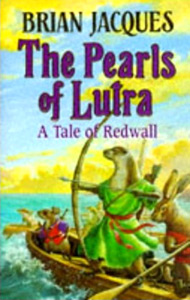 |
||
| Title: | The Pearls of Lutra: A Tale of Redwall | |
| Author: | Brian Jacques | |
| Illustrator: | Allan Curless | |
| Publisher: |
Hutchinson Children’s Books (London), Jul 1996 |
|
| ISBN: | 0-09-176536-6 | |
|
406 pages, £12.99 |
||
| Availability: | Am |
|
Jacques’ ninth Redwall novel is more of the same. Once again a horde of dastardly vermin (piratical rats, stoats, ferrets, and similar predators) threaten the peace-loving squirrels, moles, and other woodland animals of Redwall Abbey. There are multiple interlocked stories, poetry in the form of both songs and riddles, deadly backstabbing treachery among the villains, and plenty of luscious feasting among the Redwallers.
Ublaz Mad Eyes, a pine marten who is the most cunning and vicious of the pirates of the tropical isle of Sampetra, has proclaimed himself Emperor. He orders his corsair fleet to steal six fabulous pearls, the Tears of all Oceans, from the otter Holt of Lutra. The otters are slain, with one exception, but the pearls (through a series of misadventures) end up hidden inside ancient Redwall Abbey. Ublaz sends his most loyal pirates to get the pearls from Redwall, which they attempt by kidnapping elderly Abbot Durral (mouse) and young Viola (a tomboyish bankvole) and demanding the pearls as ransom.
The Abbey’s defenders, led by Martin the Warriormouse (grandson of the Martin of the original Redwall), go on a quest to rescue their friends. Meanwhile, the greedy pirates have tired of Ublaz’s cruelties (he sadistically murders his own supporters when he runs out of innocent victims) and mutiny to seize his throne and loot; ineffectively, since they are also busy doublecrossing each other. Grath Longfletch, the sole survivor of Holt Lutra, is waging her own lone-otter war of vengeance. And Tansy hedgehog, Recorder Rollo bankvole, and their friends back at the Abbey try to decipher the cryptic puzzles that tell where the six pearls are hidden. The adventure switches back and forth from one tale to another, merging and separating, until all threads converge at the climax.
If this plot is familiar, its elements have become honed and polished rather than stale. The poetry is more catchy and sprightly; the riddles (one for each of the pearls) are more varied; the villains are more intelligently sinister; the Redwall banquets are more mouth-watering; the adorable Abbey orphans have grown so impishly cute that you want to wring their necks. And there are some touches of originality, notably Ublaz’s personal guard of carnivorous monitor lizards, a cold-blooded (naturally) gang of assassins. The Pearls of Lutra is a distillation of all the best elements of the Redwall series. ![]()
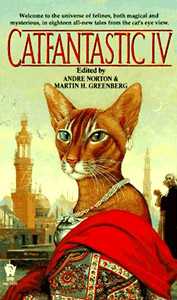 |
||
| Title: | Catfantastic IV | |
| Editors: | Andre Norton & Martin H. Greenberg | |
| Publisher: |
DAW Books (New York, NY), Aug 1996 |
|
| ISBN: | 0-88677-711-9 | |
|
314 pages, $5.99 |
||
| Availability: | Am |
|
Here is another ‘more of the same’. After a 21/2-year wait since Catfantastic III, this fourth anthology of brand-new stories contains 18 tales featuring cats.
The stories are ‘weird’, using the late 19th-century popular meaning of that word. Mercedes Lackey’s SCat, about two telepathic cats on a spaceship who help their human partner track down galactic smugglers, is clearly science-fiction. P. M. Griffin’s The Neighbor, about a sorcerer, his young apprentice, and their two cat familiars who track down a murderer in their Medieval European neighborhood, is clearly fantasy. What about Janet Pack’s One With Jazz, in which a jazz fan trying to get a job as a talent scout for a record company finds that his otherwise-apparently-normal pet cat has an uncanny talent for picking hot new bands? Twelve of these eighteen stories are clear-cut fantasies, four are s-f, and two are ‘normal’ except for the cat’s metaphorically winking at the reader.
The statistics get fuzzier broken down by types of cat. There is one story with an intelligent felinoid alien, and one with bioengineered intelligent cats. Five have cats that pretend to be normal, but talk secretly (by sign language, telepathy, or speech) with their human companions. In three, it is revealed that all cats have human-level intelligence but are hiding it. Two are fantasies with divine cats; and in one of those, Bast gives speech to all cats. Two are about loveable but obviously ‘dumb’ cats in s-f or magical situations. Most of the rest leave the reader guessing as to just how intelligent their cats really are.
For readers of the previous Catfantastic anthologies, there are six sequels continuing the adventures of cats previously introduced: P. M. Griffin’s The Neighbor (with Master Trouble), Mercedes Lackey’s SCat (with SKitty and SCat), Lyn McConchie’s Deathsong (with Many Kills), Andre Norton’s Noble Warrior, Teller of Fortunes (with Thragun Neklop), Elizabeth Ann Scarborough’s Born Again (with Mu Mao the Magnificent), and Mary H. Schaub’s The Cat, the Sorcerer, and the Magic Mirror (with Drop, the cat previously turned into a boy apprentice, who is a cat again).
All of these stories are strongly pro-cat. It would be nice to say that all are pro-animal, but the atmosphere is more katze über alles than pan-animalistic, and there are a couple of definitely snide comments about dogs. It is an open secret that most s-f authors are cat people; in fact, one of the panels at the 1996 World Science Fiction Convention was, Are There Too Many Cats in Science Fiction? Obviously, not in the opinion of the authors of Catfantastic IV. ![]()
|
|